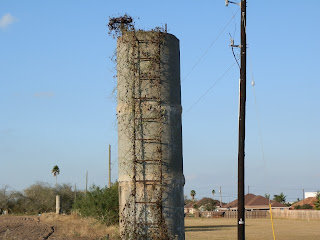Yesterday was yes, another great day. The high reached 27C
with a little cloud.
We bicycled around the resort for awhile this am. then had
to leave for Cathy’s hair appointment. After Cathy’s shearing we took a ride
over to Hidalgo which is about a 35 minute ride to the west of Mercedes. I
wanted to check out the original pump house that supplied water for all of the
Rio Grande Valley agricultural area. This was an amazing project that started
back in 1909.
 |
| There were 3 boilers like this. They had to create 500 hp to turn the pumps. |
 |
| The water gates outside the pump house. |
As we travelled around we can see the features and the different
stages of the watering process.
I will give my interpretation of the project
and hope to do it justice. It is very cool and a lot of work for the farmers.
We first noticed went we arrived in Texas most of the fields were plowed with deep furrows like potato fields are done. We found out later this is done to get ready for the watering cycle. Before watering they run over the deep furrows with an implement which shaves 3 to 4 inches off the tops of the furrows and plants the seeds.
There are a few river sized trenches dug which run to the north from the Rio Grande River which are flooded every once and a while (didn't get a picture of these). The water is then pumped into a smaller channels.
 |
| The making of the larger channels. |
 |
| Making the smaller channels. |
 |
| We would see a number of these, some with water some empty. |
Along these channels there are stand pipes with valves in them. They are opened to allow the water to go down the fields perimeter to the black plastic stand pipes.
 |
| The valve on top is covered with a vine, usually they are inside the stand pipe. |
 |
| When water is turned on it flows to the black pipes along the field edge. |
 |
| We would see these pumping stations from time to time. |
They attach plastic hoses about 10 inches in diameter to the black stand pipes and run them along the outside of the fields in a deeper furrow and put holes in them at the location of each field furrow.
 |
| The fields are deeply furrowed with the tops flattened and planted. |
 |
| Filling the field furrows |
They then let the water run down the furrows until they are watered. We noticed the orange groves have a larger trench carved out on both sides the trees.
Today the water is pumped to 80 miles of earth channels, 32 miles of concrete lined canals and 200 miles of underground irrigation. This concludes today's information session. We find it quite interesting seeing these different features.
The sad part of the day was there was no happy hour as most of the gang went to golf, but we wanted to relax anyway.
Til tomorrow...






